|
Incredible but true. Way back in 1700,
India was actually the world's second-largest economy, accounting
for 22.6 per cent of world income, second only to China. Three hundred
years on, it's among the handful at the bottom, and just chips in
with just around 5 per cent of world income. Who's to blame? Why,
the Brits, of course, goes the chorus.
Sure. Two centuries of colonial rule have taken
their toll on the economy. But the Brits left in 1947. So who or
what stopped us from doubling or trebling our share of the world
economy from the measly 3 per cent it was then? China has doubled
its share from what it was in 1952. So has Japan.
As a nation we love pointing fingers at others-the
British, the Americans, the CIA, the world economy, Pakistan-for
all our woes. Unfortunately, the economy is one area where we have
only ourselves to blame.
What was the challenge facing India in 1947?
Says Pronab Sen, Advisor, Planning Commission, ''It was to chart
a course of development from a poor, agricultural economy to a powerful
and self-reliant industrial power.'' The colonial economic system
couldn't deliver the goods. With Jawaharlal Nehru's fascination
with the Soviet Union, the journey on the path of planned development
was inevitable. ''The early planning framework has gone down in
the history of economic thought as an outstanding example of vision
coupled with technical excellence,'' says Sen. But instead of a
garden of prosperity, the path led to a quagmire of poverty and
mediocrity. Was the concept itself wrong? Or was there something
wrong with the execution of the idea? It was a bit of both.
Nehru created a whole intellectual climate
that viewed wealth-creation with suspicion and worshipped equity
over efficiency. How pervasive that attitude was can be gauged from
the Hindi films of yore-the glamourisation of poverty, the bucolic
utopias, the evil seths in sinful cities with their mills built
with the blood of the working class.
The public sector was positioned as being the
saviour of the country, from the commanding heights of the economy
that it was supposed to occupy. The market was seen as a maverick
player, which had to be constantly disciplined. So industry was
told what to produce, how much to produce, where to produce, the
cost of inputs, the cost of output, and the number of people it
could employ. There were controls on the movement of agricultural
goods, in the name of the small farmer and the consumer.
Sure, growth happened. But it was a stunted
and lopsided growth. The controls stifled innovativeness and bred
corruption. The policies of import substitution meant we couldn't
take advantage of the latest technological developments. Obsolete
technology meant increased energy consumption and higher costs.
Says D.K. Srivastava, Professor at the National Institute of Public
Finance and Policy: ''Our economic policies only led to the underexploitation
of India's full potential.''
Things have begun to change in the decade of
reforms. Industrialists don't need the government's permission to
breathe, Hindi films celebrate wealth and glamour, and socialism
is seen as a reactionary philosophy. But the distortions in the
economy run so deep that it may take India quite a while to regain
its lost place on the world economic stage.
Business before and after
economic reforms in India
 Before:
The relationship between the government and business has seen many
ups and downs since 1947. For the first 20 years, both worked in unison.
If Jawaharlal Nehru went in for a planned model of development and
placed a lot of reliance on the public sector, then industry was more
than willing to cooperate to achieve this vision. Before:
The relationship between the government and business has seen many
ups and downs since 1947. For the first 20 years, both worked in unison.
If Jawaharlal Nehru went in for a planned model of development and
placed a lot of reliance on the public sector, then industry was more
than willing to cooperate to achieve this vision.
Many industrialists of the era like J.R.D Tata,
Walchand Hirachand, Jamnalal Bajaj and Ghanshyam Das Birla shared
Nehru's vision. Tata, for example, sent his team to train staff
of the public sector companies. And hotelier M.S. Oberoi arranged
for the training of chefs at Ashok Hotel.
Things changed drastically after 1967 when
Mrs Gandhi took a decidedly leftist line.Under the licence-permit-quota
raj, entrepreneurs couldn't base their business plans on market
conditions. New Delhi would decide what was to be produced, where,
in what quantity and at what price. Bajaj Auto's Rahul Bajaj once
said that he was willing to go to jail like his forefathers, not
for the country's freedom, but the freedom to produce more than
the stipulated amount to meet the demand.
Even projects took a long time, before they
got a clearance from the government. The Mangalore Refinery (MRPL)
project, though a joint venture between the the Aditya Vikram Birla
group and the government, took 11 long years to be cleared.
The period between 1969-71 saw a slew of policies
designed to kill industry-the Monopolies and Restrictive Trade Practices
Act, the Foreign Exchange Regulation Act. Many of these policies
were used to ensure that existing businesses did not grow.
What they did was to encourage crony capitalism
as industrialists learnt to work the system.
-Swati Prasad
 After:
The reforms have not only freed industry from the licence-quota-permit
raj but have created large, new companies in fresh sectors such
as pharmaceuticals, telecommunications, and information technology.
Foreign investment has flowed in and the consumer has had far more
choice. Reforms have also spelt death for inefficient companies.
There is nothing like a supplier's market anymore, feels Pankaj
Munjal of Majestic Auto (Hero group). ''Customers have been the
one ray of hope,'' adds SRF's CEO Ravi Sinha. ''If you can compete,
you have them on your side.'' But consumers have become far more
demanding. After:
The reforms have not only freed industry from the licence-quota-permit
raj but have created large, new companies in fresh sectors such
as pharmaceuticals, telecommunications, and information technology.
Foreign investment has flowed in and the consumer has had far more
choice. Reforms have also spelt death for inefficient companies.
There is nothing like a supplier's market anymore, feels Pankaj
Munjal of Majestic Auto (Hero group). ''Customers have been the
one ray of hope,'' adds SRF's CEO Ravi Sinha. ''If you can compete,
you have them on your side.'' But consumers have become far more
demanding.
Munjal feels that the industry and the government
today work like a team, unlike before. ''We can see the change everywhere,
be it in Delhi, Lucknow or Chennai. '' Most industrialists also
claim their attittudes have changed. From lobbying, they'd have
us believe, their focus has shifted to issues related to competitiveness.
That is only partly true, most companies that
blossomed under the constraints of the l-q-p raj seem to miss the
protectionism of those days. Clearly, the people who manage these
companies are finding out the hard way that free market policies
cut both ways, leaving no scope for the slow.
-Swati Prasad
Who Killed Indian Manufacturing?
Economies move
from being agriculture-led to industry-led to being services-led.
But India has transited straight from agriculture to services.
Till the late 1960s, the government's focus
was on the public sector at one end of the manufacturing scale and
on the small-scale sector at the other, pampering both with subsidies.
The private sector was ignored.
The period between 1969 and 1972 saw the emergence
of several industry-killing legislations. The Industrial Licensing
Act, 1969, the MRTP Act, 1970, the string of nationalisations-all
belong to this period. It was only after Rajiv Gandhi tentatively
ushered in the first set of reforms in 1985 that industry picked
up again. But by then, it was too late.
-Seetha
THE INDIAN
ECONOMY: 1950-2001 |
 |
 |
|

